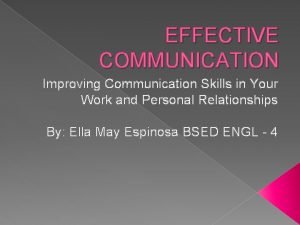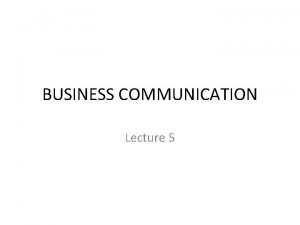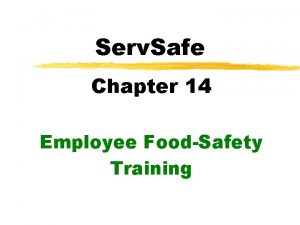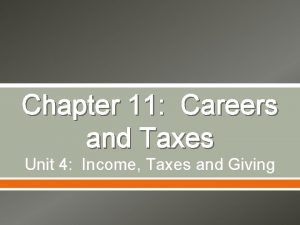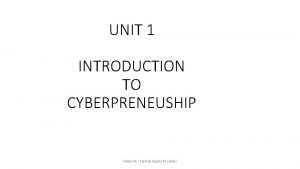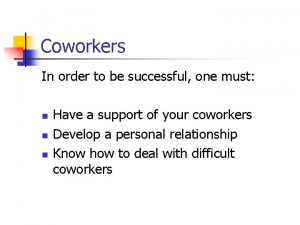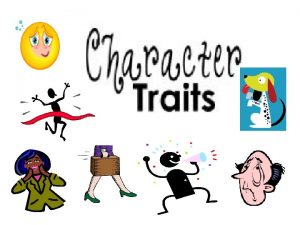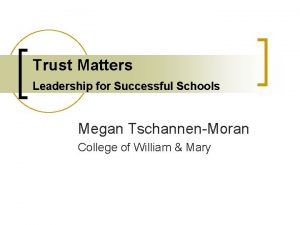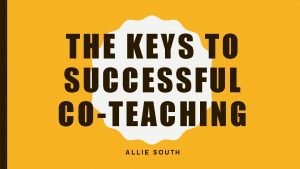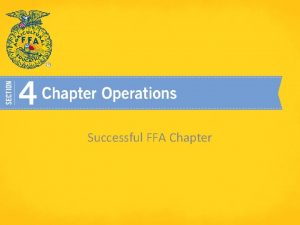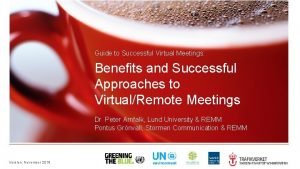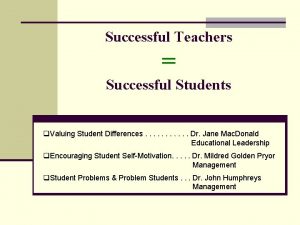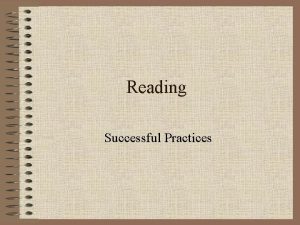Chapter 3 What Is Communication Successful communication is






































- Slides: 38

Chapter 3

What Is Communication? Successful communication is at the root of healthy relationships. communication The clear exchange of ideas and information relationship A connection you have with another person or group

What Is Communication? Person Messages Person

Different Ways to Communicate The main way people communicate is through language. Another way to communicate is through body language Facial expressions, eye contact, gestures, and posture

Different Ways to Communicate Different ways to communicate include: Face-to-face Telephone Written messages E-mail Text messaging Sign language

Safety Online Make sure that a parent or guardian gives you permission to communicate with others online. Never give out information about yourself or your family. Stay out of unsupervised chat rooms. Never agree to meet anyone in person. If an online conversation makes you feel uncomfortable, exit and tell a parent or other adult.

Different Ways to Communicate There advantages and disadvantages to different kinds of communication. When talking on the telephone or sending e-mail, visual clues such as facial expressions are absent.

Using Good Communication Skills Outbound (“Sending”) Inbound (“Receiving”) P Think, then speak P Listen actively P Use “I” messages P Ask questions P Make clear, simple statements P Mirror thoughts and feelings P Be honest with your thoughts and feelings P Use appropriate body language P Wait your turn

Communication Styles An aggressive communicator might say something rude. A shy (passive) communicator may say nothing at all. An assertive communicator isn’t shy or aggressive about expressing him or herself.

Lesson 3 Friendships

Who Are Your Friends? A friendship is an important relationship. friendship A special type of relationship between people who enjoy being together

Who Are Your Friends? Tips for Making Friends Get to know yourself Break the ice Join a club or group Offer a helping hand

Character Traits of Good Friends Good friends have the following character traits: Reliable reliable Dependable Loyal loyal Faithful Empathy empathy The ability to identify and share another person’s feelings

Building Strong Friendships You can build stronger friendships through cooperation Working together for the common good Another way of making friendships stronger is through mutual respect and support.

Peer Pressure Peers can give you support and confidence during your transition to adulthood. peers Friends and other people in your age group

Positive Peer Pressure Positive peer pressure can influence healthful choices and inspire you to improve yourself or do something worthwhile. peer pressure The influence that people your age may have on you

Positive Peer Pressure Positive peer pressure can inspire you to improve yourself or do something worthwhile. Inspiring you to improve your health and appearance, or to perform well on a team, are ways to be positive influences.

Negative Peer Pressure Daring someone to behave in a dangerous or illegal way is an example of negative peer pressure. A challenge to go against your beliefs or values is another example of negative peer pressure.

Lesson 4 Refusal Skills

What Are Refusal Skills? When peer pressure builds, use refusal skills to avoid potentially harmful situations. refusal skills Ways of saying no

What Are Refusal Skills? s T O P Say no in a firm voice. Tell why not. Offer other ideas. Promptly leave.

What Is Abstinence? Abstinence protects your health and the health of others. abstinence Not participating in health-risk behaviors Abstinence shows you have self-control.

What Is Abstinence? Abstaining from tobacco use… Protects your lungs and heart. Abstaining from alcohol and other drugs… Protects your body and mind. Abstaining from sexual activity… Protects you against pregnancy and sexually transmitted diseases.

Lesson 5

What are Conflicts? The first step in preventing conflicts is understanding what causes them. conflicts Disagreements in ideas, beliefs, or interests

Causes of Conflict Causes of conflict include: Difference of opinion Jealousy Prejudice prejudice An opinion or fear formed without having facts or firsthand knowledge

The Myth of Positive Prejudice Some kinds of prejudice can seem positive. For example, saying all French people are good cooks may sound like a compliment. However, it is really a form of prejudice. Prejudices assume things about people based on their race, culture, or the groups they belong to.

Preventing Conflicts Good communication skills and tolerance are good tools to help prevent conflicts. tolerance The ability to accept other people as they are

Resolving Conflicts Know when to walk away Refuse to fight Don’t take sides Seek help if a fight breaks out

Reaching a Compromise is an important conflict-resolution skill. compromise A skill in which each side gives up something in order to reach an agreeable solution A compromise should not go against your values.

Reaching a Compromise A compromise sometimes requires negotiation The process of talking about a conflict and deciding how to reach a compromise

Reaching a Compromise The T. A. L. K. strategy is an effective way of resolving conflicts. T A L K Take a time-out. Allow each person to tell his or her side. Let each person ask questions. Keep brainstorming.

Reaching a Compromise Some schools offer peer mediation as an option for conflict-resolution. peer mediation A process in which a specially trained student listens to both sides of an argument to help the people reach a solution

When Conflicts Get Out of Hand Conflicts that get out of hand can lead to violence The use of physical force to harm someone or something Violence is a growing problem in the United States.

When Conflicts Get Out of Hand In some communities, there is gang violence. gang A group whose members often use violence or take part in criminal activity Some teens join gangs because of peer pressure, or they seek a sense of belonging that is missing in their lives.

Avoiding Violence Learn and practice self-control. Don’t wear clothing that could be mistaken for gang clothing. Stay clear of harmful situations. Do not fight or threaten others. If you carry a purse, carry it across your chest. Don’t go to parties that might include drugs or alcohol. If someone has a weapon, report it. Be an advocate of peace. Use good communication skills.

Protecting Yourself from Violence Do not open the door to anyone you don’t know. Keep doors and windows locked. Never tell visitors or callers you are alone. When going out, tell your family where you are going and how you will get there. When walking home, try to walk in pairs, or with a group. Stay in familiar neighborhoods. Do not enter a building with a stranger. If someone tries to grab you, scream and run away. Call 911. Never get into or go near a stranger’s car.

ABSTINENCE ENVIRONMENT PEERS ADVOCACY FRIENDSHIP PHYSICAL HEALTH ATTITUDE GOAL PREVENTION BEHAVIOR HABIT REFUSAL SKILLS BODY LANGUAGE HEALTH RELATIONSHIP COMMUNICATION HEALTH SKILLS RELIABLE CONSEQUENCES HEREDITY RISK COOPERATION LONG-TERM GOAL SHORT-TERM GOAL CULTURE LOYAL SOCIAL HEALTH CUMULATIVE RISK MEDIA TECHNOLOGY DECISIONS MENTAL/EMOTIONAL HEALTH VALUES EMPATHY PEER PRESSURE WELLNESS
 What makes communication successful
What makes communication successful What makes communication successful
What makes communication successful What makes communication successful
What makes communication successful Strategies for successful interpersonal communication
Strategies for successful interpersonal communication What are the ten essentials of a successful ffa chapter?
What are the ten essentials of a successful ffa chapter? What are the ten essentials of a successful ffa chapter
What are the ten essentials of a successful ffa chapter Unit 6 managing a successful business project
Unit 6 managing a successful business project Unit 6: managing a successful business project
Unit 6: managing a successful business project Unit 6 managing a successful business project
Unit 6 managing a successful business project Secrets to successful strategy execution
Secrets to successful strategy execution Servsafe a key element to a successful training program is
Servsafe a key element to a successful training program is Saddle thrombus cat symptoms
Saddle thrombus cat symptoms The first successful english colony
The first successful english colony Factors that facilitate successful integrative negotiation
Factors that facilitate successful integrative negotiation Collision theory
Collision theory Netflix perceptual map
Netflix perceptual map Foundations u.com
Foundations u.com Signs of successful relactation
Signs of successful relactation Unit 6 managing a successful business project
Unit 6 managing a successful business project Cyberpreneur meaning
Cyberpreneur meaning Lou tice quotes
Lou tice quotes The association for successful parenting
The association for successful parenting Successful marriages and families
Successful marriages and families Higher history effectiveness of the liberal reforms essay
Higher history effectiveness of the liberal reforms essay Requisites for successful hrp
Requisites for successful hrp Significant in the success of attractions
Significant in the success of attractions In order to be successful
In order to be successful 10 attitudes of successful workers
10 attitudes of successful workers A strong desire to be successful or achieve great things
A strong desire to be successful or achieve great things Kennedy's korner
Kennedy's korner Planning a successful website
Planning a successful website Trust matters leadership for successful schools
Trust matters leadership for successful schools Toastmasters successful club series
Toastmasters successful club series 6 steps to successful co-teaching
6 steps to successful co-teaching The first successful british colony in north america
The first successful british colony in north america Was the counter reformation successful?
Was the counter reformation successful? What important attitudes do successful scientists possess
What important attitudes do successful scientists possess Pygmalion quiz
Pygmalion quiz Checklist model for project selection
Checklist model for project selection
